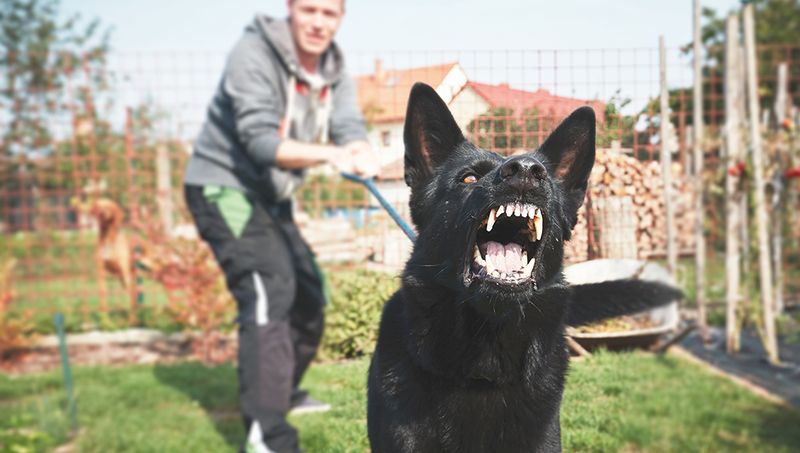Understanding dog behavior is crucial for every pet owner. While some actions are simply quirky, others can be warning signs of underlying problems. Recognizing and addressing these red flags can ensure your furry friend’s well-being and happiness. Here are 12 major red flags in dog behavior that could signal a problem.
Aggression Towards Other Dogs
An unexpected snarl or growl at the dog park can be alarming. Aggression toward other dogs is a significant red flag.
This behavior might stem from fear, lack of socialization, or even past trauma. It’s essential to intervene early. Consider enrolling your pet in socialization classes to help them feel more comfortable around their peers.
Aggression, if unchecked, can lead to dangerous situations. Seek advice from a behaviorist if necessary. Your dog’s safety and the safety of others should be a top priority.
Sudden Loss of Appetite
When your four-legged friend suddenly turns its nose up at dinner, it’s concerning. Appetite loss can signal various health issues.
From dental problems to digestive issues or even emotional distress, understanding the reason behind this change is vital. Monitor other symptoms like lethargy or weight loss.
Promptly visiting a veterinarian can prevent potential health complications. Ensuring your pet eats well maintains its overall vitality and zest for life.
Destructive Chewing
Imagine walking into your living room, only to find your favorite cushion shredded. Destructive chewing is more than just a nuisance.
This behavior can indicate anxiety, boredom, or a lack of mental stimulation. Providing your dog with engaging toys or more exercise can often curb this inclination.
Understanding the cause and providing solutions ensures your home remains intact and your dog stays content. A content dog is less likely to indulge in destructive behaviors.
Excessive Barking
Dogs bark for numerous reasons, but excessive barking can be a sign of distress. Imagine coming home to constant yaps echoing through your hallways. It could be due to anxiety, boredom, or even a medical issue. Understanding the root cause is imperative.
For instance, if your pet starts barking incessantly every time you leave, it might have separation anxiety. Consult a professional to help mitigate this issue. Addressing excessive barking not only brings peace to your home but also ensures your dog’s happiness and health.
Excessive Licking
Excessive licking can be a soothing mechanism for dogs but may also indicate skin issues or anxiety.
If your pet frequently licks its paws or other body parts, inspect for signs of irritation or allergies. Anxiety-driven licking requires behavioral intervention.
Consulting a vet can shed light on any underlying health concerns. It’s crucial to address this behavior early to prevent secondary infections or further anxiety.
Unexplained Aggression Towards Humans
Aggression towards humans, especially familiar ones, is concerning. It may stem from fear, pain, or past traumas.
Understanding and identifying triggers is essential. A sudden snarl or snap could indicate an underlying health issue. Professional intervention is often necessary to address and mitigate this behavior.
Safety should always be paramount. Ensuring a harmonious relationship between you and your pet promotes a peaceful home environment.
Constant Whining
Whining is one of the ways dogs communicate, but constant whining often indicates discomfort or anxiety.
This behavior can be due to physical pain, loneliness, or a need for attention. Observing when and why the whining occurs provides insights.
Addressing the root cause is key. Whether it’s increasing playtime or consulting a vet, ensuring your pet’s comfort is paramount. A happy dog means a happy household.
Repeated Escaping Attempts
Has your furry friend become a little Houdini, always attempting to escape? This behavior is a major red flag.
It could be driven by boredom, anxiety, or seeking mates. Ensure your pet has sufficient mental and physical stimulation daily. Strengthening your yard’s security is also wise.
Addressing the reasons behind these escape attempts ensures your dog’s safety and your peace of mind. A well-entertained dog is less likely to dash for freedom.
Fear of Everyday Objects
A vacuum cleaner sends your dog into a frenzy, or perhaps a harmless broom causes panic. Fear of everyday objects can be puzzling.
This behavior can be due to a lack of early exposure or traumatic experiences. Positive reinforcement and gradual desensitization can help.
Understanding and addressing these fears fosters a more relaxed and confident pet. A dog at ease is a joy to have around.
Changes in Sleep Patterns
A noticeable change in your dog’s sleep patterns can signal health issues. Sleeping too much or too little is worth investigating.
This shift could indicate pain, discomfort, or even age-related problems. Monitoring other behaviors helps in identifying the cause.
Consulting a vet ensures that any underlying health concerns are addressed promptly. A well-rested dog is a happy and active companion.
Ignoring Commands
Your dog used to be an obedient companion, but now it seems to disregard commands. This change is notable.
It might be due to hearing loss, confusion, or simple stubbornness. Ensuring consistent training and checking for health issues is vital.
By addressing this behavior, you ensure a cooperative relationship with your pet. A dog that listens is a joy and ensures safety in various situations.
Sudden Weight Gain or Loss
Weight fluctuations in dogs can indicate underlying health problems. Whether it’s unexpected gain or loss, it’s a cause for concern.
Factors like metabolism changes, diet, or even stress can be culprits. Regular vet check-ups help monitor your pet’s health closely.
Addressing weight issues ensures longevity and a high quality of life for your furry friend. A balanced diet and exercise are key components of a healthy lifestyle.












